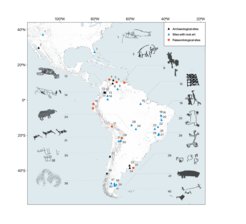
LastJourney
The interdisciplinary ERC-funded LastJourney project investigates late Pleistocene - early Holocene (LP-EH) human settlement, adaptation, and ecological impact across the varied landscapes of northwest South America in order to better understand how our species interacted with, and shaped, the continent’s rich environmental diversity.

South America was the last habitable continent to be colonized by humans, with its northwestern region acting as a transient corridor for the demographic dispersal of our species. Early settlers would have come in contact with the varied environments of northwest South America, encompassing coasts, savannahs and lowland, Sub Andean and Andean tropical forests. Moreover, this final continental migratory challenge took place amidst one of the most significant climatic, environmental, and subsistence regime shifts in human history – the LP-EH transition – which contributed to the global Late Quaternary Extinction (LQE) of megafauna, plant and animal domestication, and today’s remarkable diversity of Indigenous South American groups.
Despite its geographical importance and a wealth of archaeological and palaeoecological data across its diverse environments, northwestern South America has only been given cursory consideration to understand processes of human dispersion. The LastJourney addresses this imbalance by applying an interdisciplinary approach that integrates archaeology, archaeobotany, zooarchaeology, palaeoclimatology, palaeoecology, ancient environmental DNA, and at MPI-GEA, isotope geochemistry to research coupled human-megafauna and environmental systems.

Accounting for the loss of >80% of large mammal species in South America, the LQE coincides with a shift to a warmer and wetter climate as well as the arrival and spread of humans on the landscape during the LP-EH transition. These climatic shifts are credited with transforming the mixed paleoenvironments of the northwestern region and, in turn, altering vegetation dynamics and animal habitats which likely contributed to the mass extinction of megafauna. However, mounting evidence shows that anthropogenic pressures (e.g., predation, fire, habitat fragmentation) potentially had a more significant impact on the vegetation and megafauna populations than previously thought. In turn, the defaunation of major ecosystem engineers like the South American Giant ground-sloth and ‘elephant-like’ Gomphothere would have had fundamental impacts on land cover, vegetation succession, and nutrient cycling.
At MPI-GEA, stable isotope (δ13C and δ18O), strontium isotope, and radiocarbon analysis are being utilized in order to interpret the past diets, environments, mobility, and antiquity of museum and excavated animal specimens from LP-EH sites in northwestern South America. Evaluation of new radiocarbon dates from the LastJourney project helps contribute to the chronology of early human migrations and refine coeval occurrence records with megafauna and changing animal populations in the northwestern region of South America. Meanwhile, geochemical analysis of palaeontological and archaeological materials from LP-EH sites, when used alongside palaeoenvironmental records from the wider region, is essential to explore the varying role of humans and climate change in the dramatic faunal turnover. Results from the LastJourney project aim to provide a global comparative perspective to study the history of human colonisations, hunter-megafauna interactions, plant and animal domestications, and palaeoecological implications.



